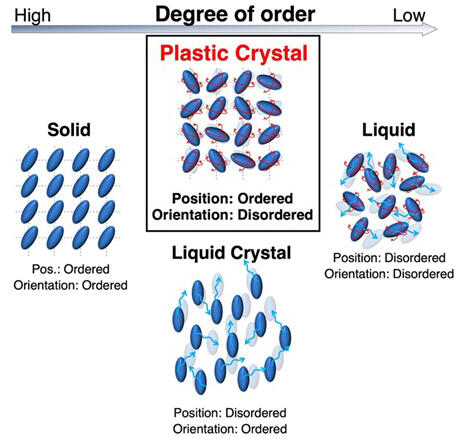A joint research group led by Nozomi Onodera (Graduate School of Engineering, Tohoku University), Assistant Professor Shun Dekura, Professor Tomoyuki Akutagawa, and Assistant Professor Tetsu Sato from the Institute of Multidisciplinary Research for Advanced Materials (IMRAM) at Tohoku University, Undergraduate Student Miyu Mashiko (at the time of the research) from the Faculty of Engineering at Tohoku University, Professor Motohiro Mizuno from the Nanomaterials Research Institute at Kanazawa University, and Assistant Professor Takuya Kurihara from the Faculty of Chemistry, Institute of Science and Engineering at Kanazawa University has, for the first time, captured a unique phenomenon in "plastic crystals"—materials that maintain their solid shape while internal molecules rotate like liquids. Specifically, this phenomenon is an electric response where applying electricity changes the orientation and shape of molecules, and this state can be maintained. This is like electrically operating two switches (molecular "orientation" and "shape"), opening the path to realizing multilevel memory that can handle more information than conventional memory devices. Their research was published in the Journal of the American Chemical Society.

Provided by Tohoku University
Most current memory devices record information using two states (binary) represented by 0 or 1, but if a single device could distinguish more states (such as quaternary states like 0, 1, 2, 3), storage density could be dramatically increased. The research group focused on plastic crystals as candidates for such multilevel memory materials. These exist in unique states that combine properties of both solids and liquids: while the material maintains a solid state, the constituent molecules can rotate relatively freely within the crystal lattice. While this molecular mobility holds potential for rapid response to electrical stimuli, it was previously thought that because the molecules move too freely, any electrically written information would quickly disappear.
In this research, the group focused on the plastic crystal phase of succinonitrile (SN), an easily obtainable organic molecule with a simple structure. When they precisely measured the electrical response of SN to externally applied voltage, they observed a hysteresis phenomenon where the magnitude of electrical polarization differed depending on how the voltage was applied. This suggests that the material remembers the history of applied voltage, representing the first step toward memory function applications.
The hysteresis shown by SN's plastic crystal phase had a very unusual form called a double P-E hysteresis loop with a two-stage structure, different from ordinary ferroelectrics. Detailed investigation of the origin of this electrical response with dual characteristics revealed that two different degrees of freedom possessed by SN molecules are involved. One is the change in orientation of the entire molecule due to the electric field. The other is conformational change where the internal structure of the molecule changes shape. SN molecules have an elongated shape but can take two forms (conformational isomers): the gauche form (which is polar) where part of the molecule is bent, and the trans form (which is non-polar) where it is straight. The group discovered that when an external electric field is applied, not only do these molecules align in orientation, but their shapes also change, and the combination of these effects produces the unique phenomenon of double hysteresis.
In other words, this material possesses two types of switches in response to electrical signals—one that "changes molecular orientation" and another that "changes molecular shape"—and their step-by-step response demonstrates the possibility of distinguishing multiple states.
Going forward, advancing the optimization of material design is expected to lead to practical applications as devices based on new principles.
Journal Information
Publication: Journal of the American Chemical Society
Title: Ferroelectric-like Polarization Switching in Plastic Crystalline Succinonitrile
DOI: 10.1021/jacs.5c04778
This article has been translated by JST with permission from The Science News Ltd. (https://sci-news.co.jp/). Unauthorized reproduction of the article and photographs is prohibited.




